Baseball, Hot Dogs, Apple Pie, and Mixed Primary Uses
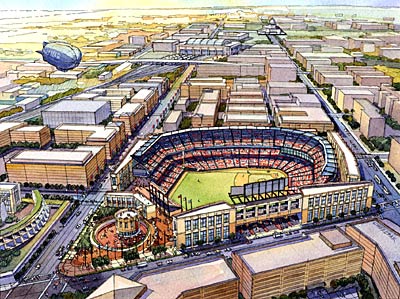 DC Baseball stadium site planning rendering.
DC Baseball stadium site planning rendering.Today's papers report, such as in this article from the Post, "D.C. Seeks to Buy Land for 'Ballpark District': Revenue From Mixed-Use Zone Would Improve Return on Stadium Investment, Officials Say that the DC Government," that DC planners are thinking beyond the confines of the stadium in terms of "creating" a destination worth visiting.
This is something that I have written about a lot, in entries such as "Baseball, Hot Dogs, Apple Pie, and Business as Usual," in the February archive, and these entries from the March archive: "Baseball, Hot Dogs, Apple Pie, and Transit;" "Denver's Delightful LoDo District;" and "Unforced Error: DC Officials Bobble the Ball When it Comes to Transit, Urban Design and the New Stadium;" and "Streetcar Short Line for (Future) Baseball Stadium Transportation (Inspired by DCist)" in the April archive. There are even more entries about this.
I hope that these writings and communications by others have made a difference.
The letter to the editor from a few days ago "Abuzz at Fenway Park," by Lou Serpa from Arlington captures the difference between disconnected big projects and stadiums or "ball parks" that are connected and an integral part of neighborhoods. Mr. Serpa figures out that Camden Yards is fundamentally disconnected from its surroundings, while Fenway Park (and by extension Wrigley Field in Chicago) is fundamentally connected.
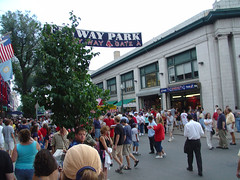 Yawkey Way. Flickr photo by Potami.
Yawkey Way. Flickr photo by Potami."On a recent visit to Fenway Park in Boston, I was struck by the proximity of the park to the surrounding streets and by the high level of energy and enthusiasm among fans, vendors, hawkers and pedestrians. Yawkey Way is a public street that is closed to traffic during games. It is not only immediately adjacent to the park but just feet from the admission gates. Yawkey Way is open to pedestrians whether or not they have tickets to a game.
It is possible to mingle with the crowd there, watch the game on any number of televisions and buy drinks and snacks. The area also is a place for smokers, who are not allowed to smoke inside the park. As nice as Camden Yards is, it does not have the "buzz" of Fenway. One reason is the long, dull walk from the parking lots at Camden Yards to the admission gates.
Many talk about Fenway Park and ways to re-create some of its finer features, but I have heard little about trying to re-create the "buzz" there. What goes on in the surrounding streets contributes much to the charm and attractiveness of Fenway, so it would be nice to consider this element when designing the new D.C. ballpark.
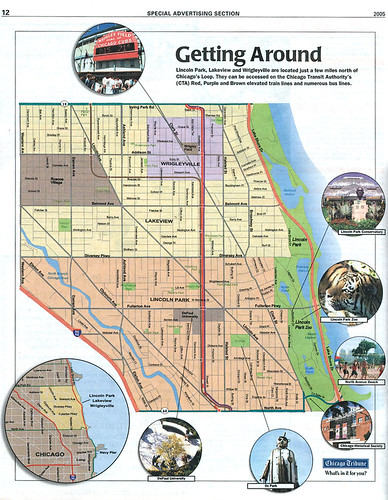 Flickr image by DawnM.
Flickr image by DawnM.There are difficulties, touristification-sportsfanification end up reshaping the neighborhood in fundamental ways.
Matt Jacob from DC also wrote a letter to the editor, "Architecture to Avoid," in response to a Benjamin Forgey column looking for some signature stadium. While Mr. Jacob doesn't say so, it's significant that stadia like Fenway Park or Wrigley Field are still functioning beautiful places, while many of the baseball parks from the last 30-40 years have been demolished. Mr. Jacob writes:
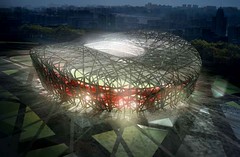 Beijing Stadium
Beijing StadiumBenjamin Forgey hopes the new Washington Nationals ballpark will embrace a bold design ["Stepping Up to the Plate for a Home Run Opportunity: Stadium Design Can Both Enhance and Be Enhanced By Monumental Washington"], but if the proposed Beijing Olympic stadium pictured with his article is what he has in mind, no thanks. The design for the Beijing stadium looks like a huge spiral slice of pineapple that got caught in a fishnet. Mr. Forgey may believe that the traditional look of Oriole Park "has run its course," but I beg to differ.
The Nationals' new ballpark should not be a cookie-cutter copy of Oriole Park or any other baseball stadium, but neither should the desire to build something unique lead the architects to design anything resembling the Beijing monstrosity.
In short it comes back to Jane Jacobs and "mixed primary uses" as well as the creation of "places" and the idea of layering (Fred Kent) or triangulation (William H. Whyte) rather than big projects and buildings.
Don't let Herb Miller build a bunch of big box stores there. Work on creating a real place that isn't just about extracting the maximum amount of cash out of people (i.e., Harborplace in Baltimore as opposed to the boardwark along the Harbor and places like Fells Point).
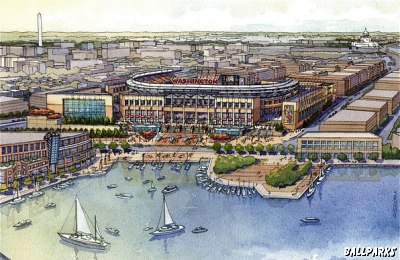



0 Comments:
Post a Comment
<< Home